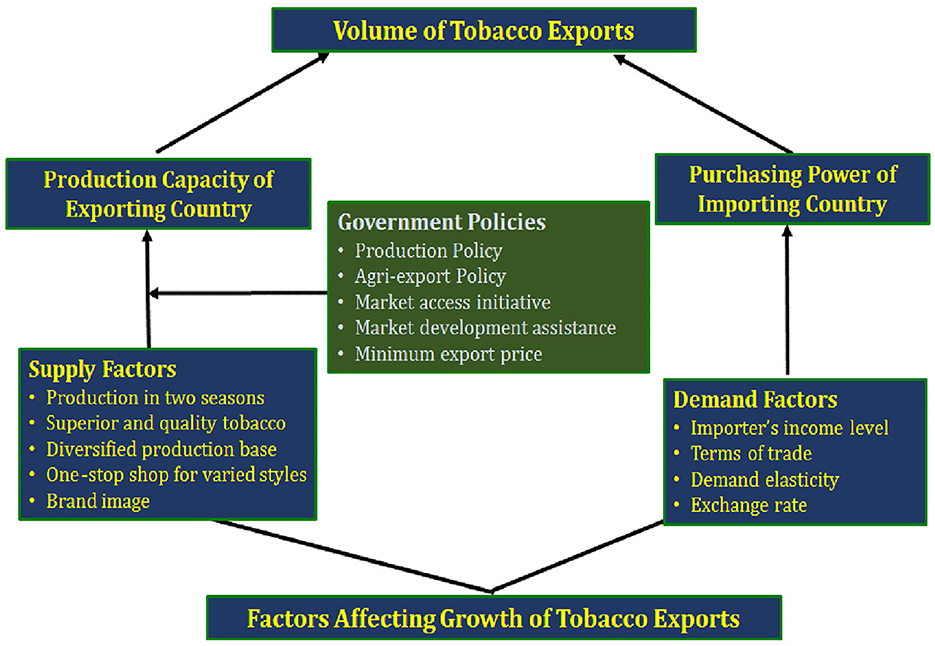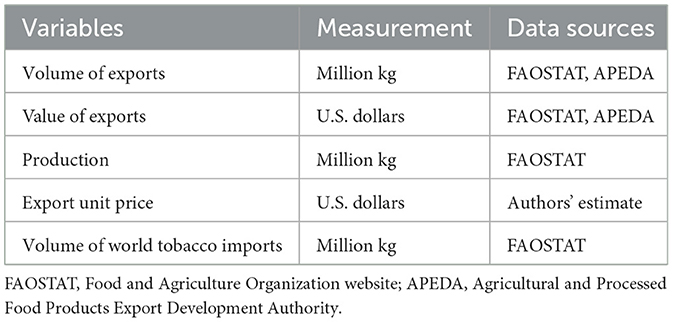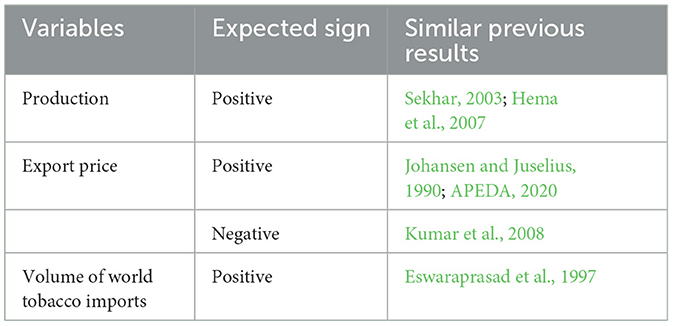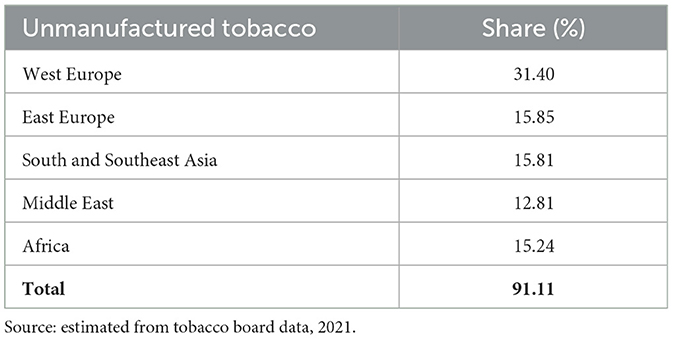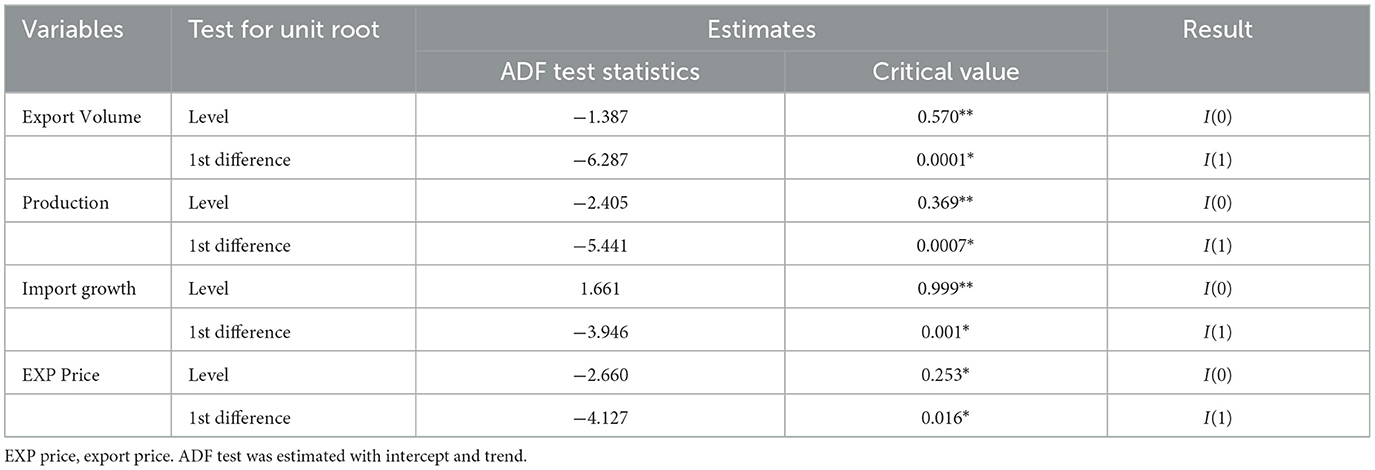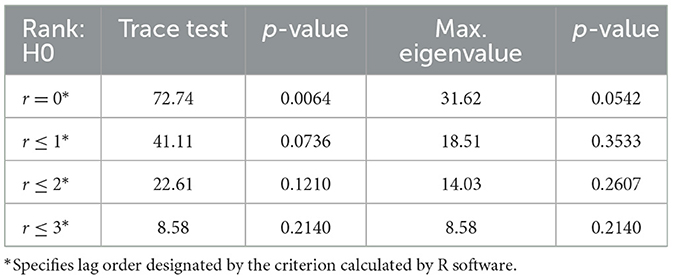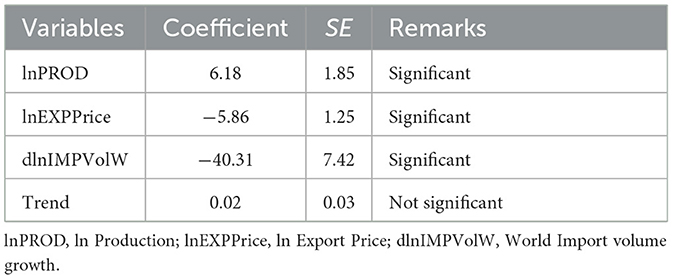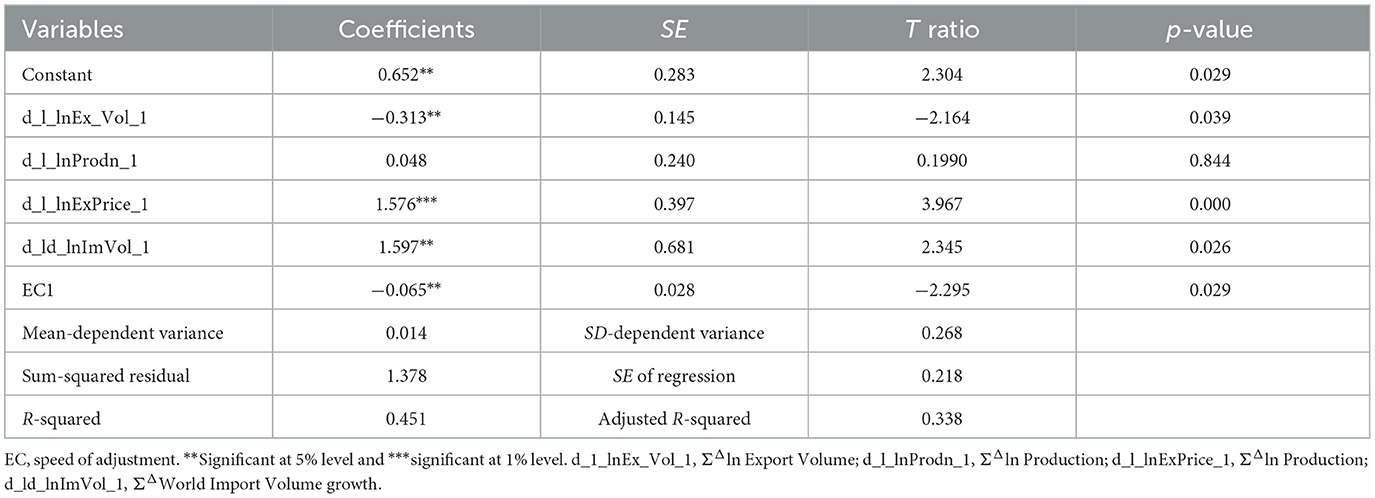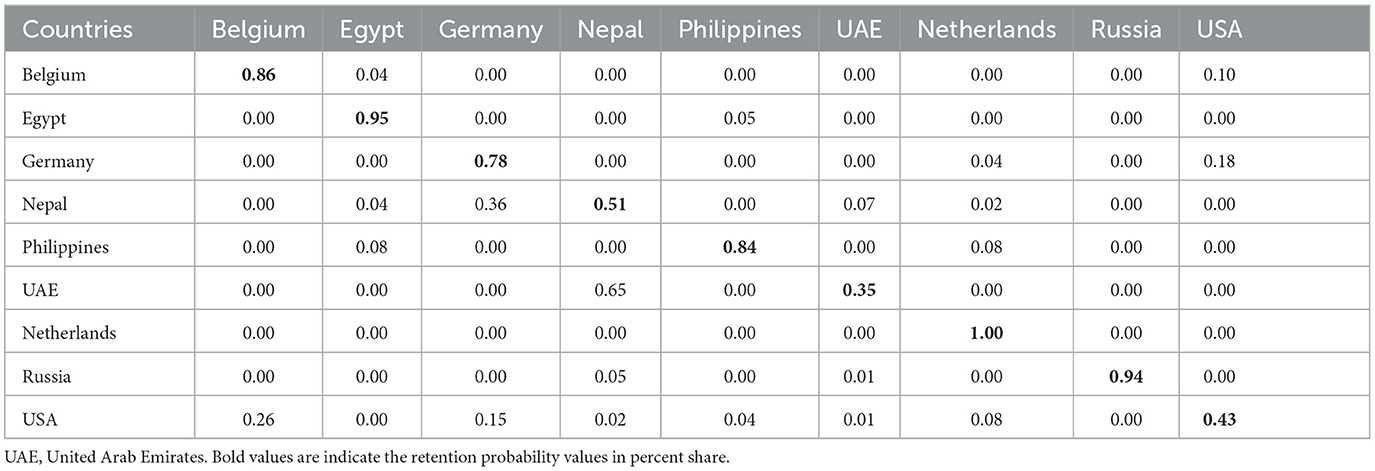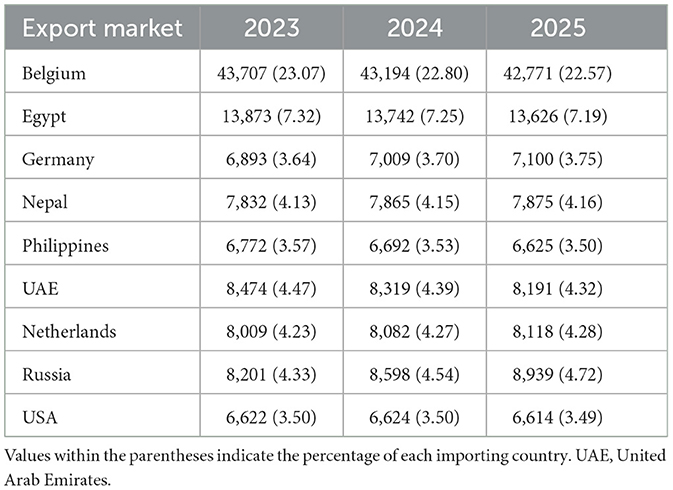Econometric modeling of tobacco exports in the milieu of changing global and national policy regimes: repercussions on the Indian tobacco sector
- 1Division of Post-Harvest and Value Addition, Indian Council of Agricultural Research (ICAR)-Central Tobacco Research Institute, Rajahmundry, India
- 2Natural Resource Management, Indian Council of Agricultural Research (ICAR)-Central Coastal Agricultural Research Institute, Goa, India
- 3Department of Agricultural Economics, Acharaya N G Ranga Agricultural University (ANGRAU), Bapatla, Andhra Pradesh, India
- 4Department of Agri-Business, California State University, Fresno, CA, United States
- 5Department of Markets, Trade, and Institutions, Indian Council of Agricultural Research (ICAR)-National Institute of Agricultural Economics and Policy Research, New Delhi, India
- 6Department of Economics, Pondicherry University, Pondicherry, India
- 7Indian Council of Agricultural Research, New Delhi, India
Introduction: Tobacco, an important commercial crop, plays a crucial role in farmers' incomes and livelihoods to a sizable population and contributes significant exchange earnings to the Indian economy. Currently, India is the second-largest tobacco producer after China, with a production of 758 million kg (13% of global production) and exports of ~190 million kg of tobacco (9% of global tobacco export volume). However, there are uncertainties surrounding the tobacco sector, such as growing public health and environmental issues associated with tobacco production and consumption and changing national and international tobacco-related policy regimes. In this context, the current study investigates the determinants of tobacco exports and geographical shifts in export destinations over the years.
Methods: The statistical models employed are co-integration, and vector error-correlation models to test the short-run and long-run dynamics relationship between tobacco exports and the explanatory variables, and the Markov chain approach to find out geographical shifts in export destinations.
Results and discussion: The econometric model estimated the relationship between the tobacco export volume with domestic production, export price, and global demand for Indian tobacco, and investigated the geographical shift in export destinations of tobacco in the context of changing global and national policy regimes on the sector. The econometric modeling framework confirms that there exists a statistically significant relationship between Indian tobacco export demand, domestic production, export price, and world demand for Indian tobacco. The geographical shift was evident in major export destinations during the post-WHO-FCTC (Framework Convention on Tobacco Control) regime. The model findings direct that India should take advantage of the export price, and global demand for tobacco as India ratified WHO-FCTC; there is no scope for horizontal expansion of the area under tobacco. This modeling framework aids as a tool to direct and explore the possible options with a greater emphasis on export-centric farming system in tobacco production by augmenting crop compliance and quality to meet the standards of international markets.
1 Introduction
Agricultural exports from the commercial crop sector contribute significantly to employment generation, farmers' income enhancement, and foreign exchange earnings in a developing economy like India. In the post–World Trade Organization (WTO) regime, many countries have realized the potential of agricultural commodities exports as a vehicle for transforming the agricultural sector, economic development, and farmers' prosperity. Hence, agricultural exports are the strategic drivers of rural economic growth, which enhance the adoption of cutting-edge technologies and farm practices, which, in turn, improves agricultural production and productivity and reduces poverty. The export prospect unleashes the agricultural sector to augment the productive capacity of a nation to its full potential. In the recent past, India has emerged as one of the key exporters of agricultural commodities in the world. Currently, the Government of India is emphasizing augmenting agricultural exports, which demands a proportionate increase in agricultural production and a greater degree of export orientation. Hence, enhanced agricultural production with a special emphasis on export-oriented crops is necessary with the emerging trends in commercial agriculture to enhance crop productivity, quality, and value addition and, finally, link farmers to overseas markets.
In the post-WTO regime, agricultural exports mainly from developing countries received considerable attention due to volatile global commodities prices, inelastic supply, and trade distortions by key players in several commodity markets around the world. It is interesting to learn that, according to Janvry and Sadoulet (2010), agricultural growth in India has a significant impact on poverty reduction, with a 1% growth in agriculture being two to three times more effective in eliminating poverty than the same growth originating from non-agriculture sectors. This highlights the importance of the agricultural sector in promoting inclusive growth in the country. Similar to many other less developed countries, it is interesting to know that tobacco leaf is a significant contributor to Tanzania's foreign exchange earnings, accounting for ~7% of total export earnings in 2015. This indicates the importance of the tobacco sector to the country's economy (UNIDO, 2012).
In India, tobacco plays an economically significant role in terms of farmers' incomes, livelihoods, and agricultural exports. Indian tobacco accounts for ~13% of global production and ~9% of global export volume (FAOSTAT, 2023), and the sector employs millions of people. However, India has vast potential to export commercial agricultural commodities like tobacco, cotton, and spices to international markets across the globe. Largely, exports of high-value commercial crops have been an important source of earning foreign exchange, and in the future, its contribution will increase further, drive export growth, and play a noteworthy role in driving the economic growth of low- and middle-income countries.
Against this background, the study aims to examine the performance of Indian tobacco exports, analyze the structural changes in the national and international policies on the tobacco sector, and suggest empirical evidence to prescribe policy implications for the sector to focus on the export-oriented production system and diversify tobacco growing regions to other viable alternative crops to minimize impact on public health and environment in juxtaposition with the global and national policies on the tobacco sector. The specific objectives of the study are to identify the major determinants of tobacco export performance during the 1980–2019 period and assess the geographical shift in tobacco exports during pre– and post–Framework Convention on Tobacco Control (FCTC) regimes.
2 Literature review
Different countries have experienced different factors as stimuli for tobacco cultivation. For instance, in Bangladesh, factors such as the older ages of the farmers, a low level of literacy, short-term financial support by tobacco companies, and the hassle-free selling of tobacco products in the market were the guiding considerations for farmers to cultivate tobacco. These results strongly advised the government and other private companies to provide institutional support given to tobacco growers should be extended to non-tobacco farmers to encourage other alternative crops (Talukder et al., 2020). However, in a two-country comparative study related to compliance with the FCTC, ratified by Slovakia in 2004 and Finland in 2005, the tobacco-regulating policy based on the implementation of the FCTC was measured in terms of each country's institutional structure supporting a smoking-free environment and the implementation of selected articles of the convention (Pavlikova et al., 2020). In Finland, the anti-tobacco policy responsibilities were assigned to the institutions, whereas in Slovakia, there are no specifically responsible institutions. The United Nations' Sustainable Development Goal (SDG) 3 was intended to “ensure healthy lives and promote wellbeing for all age groups”. This includes target 3a, which aims to reinforce the FCTC implementation. In Indonesia, a research study reported that the variables that influence the decision of the farmers to cultivate tobacco or other crops as they provide key perceptions into their economic livelihood, which may aid in the development and implementation of policies that shape tobacco production and tobacco control (Gumilang et al., 2020). It was indicated that the decision-making of tobacco farmers is multifaceted and foreseeable. However, access to finance, literacy levels, weather information, and market prices have played an important role in the decision-making of the farmers. For instance, in India, the policy-led strategy used in the southern state of Andhra Pradesh to control crop size in flue-cured Virginia (FCV) tobacco has emerged as one of the potential tools to promote and shift from tobacco to other economically viable crops framers with their own knowledge and farming experience, which have recently been observed in the state's tobacco-growing regions (Reddy et al., 2017).
In India, according to the findings of the Global Adult Tobacco Survey (GATS) 2016–2017, a major portion of adults (both smokers and non-smokers) are exposed to secondhand smoke (SHS) in their home environment, and other public spaces, particularly in restaurants, workplaces, and public conveyance (Tripathy, 2020). Between the two sexes, women are more exposed to SHS in the household, whereas men are more exposed in public places. Furthermore, the high SHS exposure among youth is also a concern. Thus, there should be stringent enforcement of legislation to safeguard a 100% smoke-free environment in all public places and other smoking areas of the country.
In this context, there is a need to conduct research to explore alternative enterprises for tobacco in major producing countries. The diversification of tobacco cultivation is inevitable across the globe, with the support of accomplishing the SDGs in lower and middle-income countries. Nevertheless, crop diversification programs in tobacco-growing regions have inadequate scope and impact at the ground level in low- and middle-income countries. However, Malawi, the most tobacco-dependent country in the world, perceived structural barriers to tobacco diversification, namely, its perceived economic importance, a lack of alternative enterprises, bestowed industry interests, and differentiated conflict between tobacco-control advocates and tobacco growers (Smith and Fang, 2020).
In India, tobacco has unique socioeconomic dimensions because of its contribution to the domestic economy in terms of livelihoods and farm incomes to the sizable population in the entire tobacco supply chain, excise revenue, and foreign exchange earnings to the national exchequer. The unique feature of the FCV tobacco production system in India is crop-size fixation, which is a regulatory mechanism that imparts stability in crop production every year in India in consonance with domestic and export demand. Nevertheless, such a regulatory mechanism was not in place for other commercial crops, resulting in high price volatility. There was an immediate need for such crops to have similar regulatory apparatus to minimize price volatility (Reddy and Reddy, 2022). It was evident that tobacco cultivation significantly enhanced the income of tobacco farmers, and it is a major source of livelihoods for resource-poor farmers in tobacco-growing regions of the country. The livelihood security at the local/regional level needs to be considered regarding some of the SDGs of the United Nations, such as SDG 2, related to zero hunger; SDG 3, related to good health and wellbeing; SDG 5, related to gender equality; and SDG 8, related to decent work and economic growth (Krishna et al., 2020).
The WHO FCTC is the first global treaty that went into force on February 27, 2005. It is one of the most rapidly and widely embraced treaties in the history of the United Nations. Presently, there are 168 signatories and 182 parties covering more than 90% of the global population. The main provisions of the FCTC contain the instruments to decrease tobacco consumption in the world. In 2004, the Government of India ratified the FCTC, which solicits key strategies for reducing the demand and supply of tobacco. Tobacco consumption can be reduced through both demand and supply-side policy instruments. The demand-side measures (Articles 6–14) include mainly price and tax measures, the regulation of the contents of tobacco products and tobacco product disclosures, education, and communication, among others. The reduction of the supply-side measures includes (Articles 15–17) the provision of support for economically viable alternative activities and the control of illicit trade in tobacco products (WHO—FCTC, 2015). It is important to note that under Article 17 of the WHO FCTC, parties agree to promote economically viable alternatives for tobacco workers and growers. This is to be done in cooperation with each other and with international and regional intergovernmental organizations. Additionally, under Article 18, parties agree to protect the environment and the health of individuals in relation to tobacco cultivation and manufacturing within their countries. These are important steps toward promoting sustainable and responsible tobacco production and mitigating the negative impacts of the tobacco industry (Espino et al., 2013). The FCTC is an agreement between governments and becomes obligatory only on those who have ratified it. The parties under this treaty cannot automatically implement the FCTC in their respective countries. The governments that ratify the FCTC need to pass national legislation to implement the treaty in their country; subsequently, the treaty becomes national law, and countries can enforce it to their people.
Tobacco-control policies have been implemented to reduce the demand and supply of tobacco across the world. The WHO FCTC is an international agreement among 182 member countries that have introduced various measures to combat the complex nature of tobacco, including non-price, price, and tax measures. India, as a signatory to the FCTC, is committed to supporting the measures aimed at reducing the supply and demand for tobacco (WHO—FCTC, 2015). In addition, every year, the WHO observes May 31 as World No-Tobacco Day to raise public awareness about the health hazards associated with tobacco use and discourage all forms of tobacco consumption. In addition, the Cigarettes and Other Tobacco Products Act (COTPA), a significant national law passed by the Government of India prohibiting the advertising of tobacco products and regulating the trade, commerce, production, supply, and distribution of tobacco products as a measure from the demand side, went into force in 2003 (Ali et al., 2020).
3 India's role in global tobacco markets
Currently, India stands second in tobacco exports after Brazil, and its share in global exports has gradually increased from 4.6% in 1990 to 7.80% in 2020 (FAOSTAT, 2021). Nevertheless, tobacco's share in the country's agricultural exports was ~2% in the 1980s and has marginally increased during the past four decades, reaching 3% in 2020 (FAOSTAT, 2021). A major share of the Indian tobacco, mainly FCV, which accounts for more than 85% of tobacco leaf exports (Tobacco Board, 2021–22). and Burley, is intended for international markets. To find the major driving factors of Indian tobacco exports during the past four decades, the study was conducted as a first of its kind to analyze the determinants of tobacco exports through co-integration and vector error-correction models. The major determinants were covered along with the identification of geographical shifts and new markets for tobacco exports during pre- and post-FCTC regimes. Therefore, the article is intended to make a noteworthy contribution to the existing literature, both from a scientific and a policy perspective. Thus, on one side, any volatility in the export market creates a negative impact on the prices and incomes of tobacco growers in India while, on the other side, are factors such as national and international policies on the tobacco sector, growing health consciousness, public awareness about tobacco-related health risks, and annoying stigma associated with tobacco are gradually gaining significance, which characterizes upcoming tasks for tobacco production.
3.1 Trade in developing economies and conceptual framework of tobacco trade
The factors influencing the export of agricultural commodities in developing countries during the post-WTO era have been a topic of debate for a long time. Understanding the geographical shifts and determinants of past performance, as well as the magnitude of the relevant variables in the changing policy regime, is crucial for the welfare of the tobacco sector. Some research studies have shown that internal determinants play a significant role in some countries, while external determinants are significant in others. The literature on the co-integration technique, a method of time-series regression, is abundant, with some reports emphasizing factors that are external to individual countries, while others highlight internal factors that dampen agricultural export growth. The latter includes domestic trade policies, infrastructure bottlenecks, shortage of export credit, and tax systems (Gbetnkom and Khan, 2002). Export growth is influenced by demand and supply factors. The latter are push factors that directly affect the productive capacity of the country. In India, the supply factors for tobacco, such as its availability in two crop seasons, superior quality tobacco, diversified production base, and brand image, influence the production and export volume. Existing macroeconomic policies, such as production policies, liberalization and open general licenses, market access initiatives, market development assistance, and minimum export prices, also give an impetus for production and export volume. However, demand factors are exogenous and pull a foreign country to import from another country. For instance, having a high income raises the purchasing power of an importing country, increasing its capacity to import more goods and services. The exchange rate also influences imports. The relationship between demand and supply factors and the ways they affect tobacco export volume are illustrated in Figure 1. The selection of variables or statistical analysis differs in studies on structural dynamics and determinants of agricultural exports, with the general interpretation in developing countries being that exports are more responsive to price variables (Balassa, 1990; Tshibaka, 1997).
Globally, many countries are experiencing a change in the pattern of export of their commodities; India is also changing its pattern of export commodities in the post-liberalization era. These developments in the international trade scenario in recent years and changes in India's foreign trade policies had broad implications for India's agricultural exports.
4 Material and methods
4.1 Data sources
The time-series data spanning four decades, from 1980 to 2019, were collected from various sources (Table 1). Data on tobacco exports compiled from the Agricultural and Processed Food Products Export Development Authority; the Ministry of Commerce and Industry, Government of India (APEDA, 2021); and the official website (www.fao.org/faostat/en/#home) of the Food and Agriculture Organization were used for statistical analysis (Tobacco Board, 2021–22).
4.2 A priori expectations
India has a comparative advantage in tobacco production as it ranks second in both production and exports in the world. Furthermore, it is assumed that the production and exports of tobacco are positively related. Enhancing production leads to more availability of export surplus and, in turn, higher exports and the development of new export markets. Thus, production and exports are directly associated. It is expected that export prices can have both positive and negative relations with export performance. The decline in export prices is negatively associated with the performance of exports and vice versa (Table 2). The exports of commercial crops emerged as a viable source of exchange revenue in developing countries.
4.3 Model specification and explanation of variables
In this study, we used relevant variables among the many noted based on the a priori expectation of their effect on tobacco exports (Table 2). Tobacco export volume was set as the dependent variable, and the following constructed model as described in Equation (1) was estimated to know the significant determinants of Indian tobacco exports.
Model:
where E is the tobacco export volume from India, R is the export price for India, Q is the tobacco production volume, and Iw is the volume of tobacco imports of the world.
4.4 Unit root tests
Time-series data can be classified as either stationary or non-stationary based on their data-generating process. Economic time-series data are typically non-stationary, meaning that they exhibit a non-constant mean and variance due to the presence of the unit root property. Ignoring this property can result in spurious regression, where a statistical model shows a significant correlation between variables but lacks any meaningful relationship. To determine the presence of unit roots in selected variables, this study employed the augmented Dickey–Fuller (ADF) test. The test was conducted with and without a deterministic trend (T), and the optimal number of lags in the ADF equation was determined using the Akaike information criteria (AIC) and the Schwarz information criteria (SIC). The ADF test was estimated using the ordinary least squares method was given in the Equation (2).
where ΔYt = Yt − Yt−1 is the first difference of a variable considered for unit root test; εt is white noise, signifying independent and identical distribution of error term with mean zero and variance σε; T is the time or trend variable; β0 is the intercept; β1, γ, and φ are slope coefficients of regression.
4.5 Co-integration technique
The co-integration framework is a widely used method by empirical economists. It has many approaches, namely, (a) the Engle-Granger approach, (b) the Johansen–Juselius approach, and (c) the autoregressive distributed lag model. Among these, the Johansen–Juselius approach (Johansen and Juselius, 1990) is extensively used but is sensitive to the stationarity of the data series. The major requirement for using this methodology is that all the variables should be non-stationary with the same order of integration (I). The Johansen–Juselius cointegration approach commences with the definition of a vector autoregression (VAR) given in Equation (3) as follows:
where Xt represents a (K × 1) vector of I(1) series at period t, πi (I = 1,..., p) in the (K × K) coefficient matrices of the lagged endogenous variables, and ε is a (K × 1) vector of error terms or innovations assumed to be independently identically distributed as ε~N(0, ∑). The optimum lag p is selected based on the AIC or SIC test. The two Johansen tests are used to identify the number of co-integrating vectors (r) that are equal to the rank of the π matrix, namely, the “maximal eigenvalue” test, for hypotheses on individual eigenvalues and the “trace” test, for joint hypotheses:
Log-likelihood ratio of max eigenvalue (r, r + 1) = –T ln (1–λr+i)
Log-likelihood ratio of trace test (r) = .
4.6 Vector error-correction model
To find the short-run association among the variables, the VAR equation (Equation 3) is expressed as follows for the vector error-correction model (VECM) as given in the Equation (4):
Γi = −(I − π1 − … − πi), for i = 1, …p = 1
π = −(I − π1 − …−πp)
where I is the (K × K) identity matrix. Because the error-correction term πX(t – p) should be made stationary as the other terms in the equations are stationary variables I(0), that equation would be valid and meaningful. If r = 0, the process is all I(1), implying that series are not cointegrated; otherwise, no linear combinations exist. If r = n, then the π matrix is invertible, and hence, the processes are all I(0), implying that all K linear combinations must be stationary. However, usually, this is the case if the rank of the matrix is between zero to K. If the matrix does not have full rank, it can be decomposed into two matrices, namely, α and β, where α measures the speed of adjustment to the long-run equilibrium, otherwise called the loading matrix, while β measures the cointegrating vectors.
4.7 Markov chain approach
It is applied to investigate the structural dynamics in trade or production systems, whose movement through time can be measured in terms of a single outcome variable (Dent, 1967). The practical utility of the Markov chain approach has been extensively recognized in the analysis and forecasting of many economic variables, particularly when the process is perpetual but has a gradual change (Fisher, 1967; Mandanna et al., 1998). This is a technique of analyzing the past behavior of some economic variable to forecast the future behavior of the same variable. In the present study, the average exports to a particular country, for instance, India's export quantity is considered to be a random variable, depends only on its previous exports to that country, and was denoted algebraically by Equation (5):
where Ejt denotes exports from India to the jth country during year t, Eit−1 is exporting to the ith country during year t – 1, Pij is the probability that exports will shift from the ith country to jth country, ejt is the error term, and m is the number of importing countries. The transitional probabilities, Pij, which can be arranged in a (j columns × i rows) matrix, have the following properties: 0 ≤ Pij ≥ 1, for all i.
The anticipated share of Indian exports during a particular period, t, was found by multiplying the export volume to the selected countries during the preceding period (t – 1) using the assessed transition probability matrix (P). The minimum absolute deviation assessment technique was employed to estimate the transitional probability, which minimizes the sum of absolute deviations (Wagner, 1959).1 The conventional linear programming technique was used during estimation as this satisfied the properties of transitional probabilities of non-negativity restrictions and row sum constraints. The linear programming formulation is specified per Equation (5):
subject to
where Ṗ is a vector of the probabilities Pij; 0 is a null vector; In refers, in this section, to an identity matrix of appropriate dimension; e is the vector of absolute errors (|U|); D is the vector of exports to each country; C is the block diagonal matrix of lagged values of D; G is the grouping matrix to add row elements of P organized in Ṗ to unity; and Ṗ vectors are set to obtain the transitional probability matrix as described in the Equations (6)–(9).
The predictable shares of export were calculated by the Equation (10) is given below
where Djt is the predicted proportions of the jth country's share at time t and Dt−1 is the observed proportion of the ith country's share at time t – 1.
The anticipated export shares of each country during period t were obtained by multiplying the export quantity in the preceding period (t – 1) with the transitional probability matrix.
5 Results
5.1 Economic significance and trends in tobacco exports
India's export consists of manufactured and unmanufactured tobacco. The unmanufactured accounts for ~85% in volume and 70% in value. Out of this, the FCV and Burley variants of tobacco are major ones, having shares of 69 and 18%, respectively (Lee, 1995). Because India has a diversified base of production, it provides a one-stop shop for different styles, qualities, and price ranges of tobacco in the world. The export market for unmanufactured tobacco is concentrated mainly in the regions of South and Southeast Asia, West Europe, East Europe, the Middle East, and Africa (Table 3). In addition, tobacco product exports from India include chewing tobacco (6.8%), cigarettes (4.1%), and hookah paste (2.1%).
Because of the huge socioeconomic significance of the tobacco sector in the country during the past few decades, it has received a great amount of attention from various stakeholders, namely, Indian Council of Agricultural Research–Central Tobacco Research Institute, Tobacco Board, Trade, and Industry. Thus, the research and development and other institutional support have enhanced crop productivity and quality, which, in turn, paved the way for the growth of tobacco exports.
From the trend analysis of tobacco exports, it is evident that the tobacco export volume from India has increased from as low as 71 million kg in 1980 to 254 million kg in 2013. In terms of value, the corresponding figures for 1980 and 2013 are US$151 million and US$847 million, respectively, and thereafter gradually started declining, finally reaching US$172 and US$592 million, respectively, during 2019 (Figure 2).
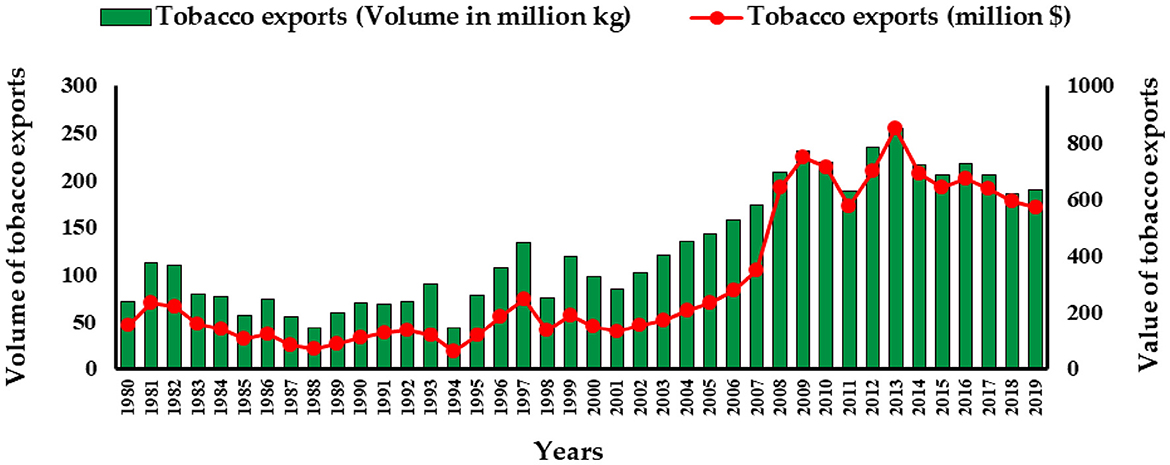
Figure 2. Trends in tobacco exports (volume and value) from India from 1980 to 2019. Source: Lee (1995) and Tobacco Board (2021–22). Tobacco exports are reported in U.S. dollars.
5.2 Descriptive summary
Table 4 depicts the general trend of the tobacco industry in India. The mean and median values of the selected variables are relatively close, except for some variables that display a wide range between their minimum and maximum values. Among all the dependent and explanatory variables examined, production volume, export volume, and world exports exhibit the highest variability. Between 1980 and 2019, tobacco production in India had a mean, maximum, and minimum value of 626, 830, and 340 million kg, respectively. Likewise, the corresponding export volumes during the period were 146, 254, and 43 million kg, respectively. In terms of the export price, India recorded an average of US$2,208/ton, with a maximum of US$3,334/ton and a minimum of US$1,302/ton over the same period.
5.3 ADF test for unit root
Johansen and Julesius's cointegration technique requires that all variables be integrated in the same order. Hence, ADF tests are used to find out the unit root in the data series. The outcomes, along with critical values, are presented in Table 5. The null hypothesis of the test is that the variable has a unit root. The comparison of ADF statistics with critical values reveals that not all the variables are stationary at their levels, implying the acceptance of the null hypothesis. They all become stationary at the first differences. This means that they have only a single unit root. Therefore, we can specify the export supply models in their levels without the risk of obtaining spurious regressions.
5.4 Johansen–Juselius cointegration (long-run coefficient)
Prior to estimating Johansen–Juselius cointegration, determining the appropriate lag length is crucial. To follow the method used by researchers (Reddy and Reddy, 2022), an unrestricted VAR model with three lags was initially chosen, considering the potential influence of dependent variables on exports. Subsequently, the lag length was gradually reduced, and the model was statistically tested against the unrestricted model using the likelihood ratio test. Additionally, the AIC and SIC tests were used to determine the optimal lag length. Based on these tests, a lag of 2 was identified as optimal and was therefore used for the unrestricted VAR estimation. The long-run results of the tobacco export model determinants are presented in Table 6, which includes the trace and maximum eigenvalue test statistics related to the rank of the VAR model. These tests indicate the number of linear combinations of variables that make the error term stationary. Both tests rejected the null hypothesis of zero ranks at a 5% level of significance, confirming the existence of at least one co-integrating vector. The trace test suggests the possibility of at least two co-integrating vectors at a 10% level of significance by rejecting the null hypothesis of two co-integrating relationships, while the maximum eigen test accepts the null. Therefore, the rank of the VAR matrix is determined to be one. Johansen–Juselius co-integration was then estimated using this information, and the coefficients of co-integrating vectors are presented after being normalized by export volume.
The analysis shows a strong association between the dependent and independent variables used in the study. The normalized coefficients represent long-run coefficients, indicating a robust relationship between the selected four variables, and can be expressed in elasticity. As expected, a positive relationship was found between export volume and production. Similarly, the coefficients of export price and growth rate of world import, a proxy for competition intensity from other countries, detailed in Table 7, suggest a negative relationship.
The greater the export of other competing countries, the lesser the export from India. The negative export price indicates that non-price factors play a significant role in determining the price. The greater the price increase, the lower the exports. This implies that farmers' remunerations can be increased only by reducing the cost of production through the development of high-yielding varieties and agro-technological interventions. Table 8 presents the results of the VECM model, which examines the short-run dynamics between the variables of the co-integration equation.
The speed of adjustment (EC) indicates the time the system moves toward the long-run equilibrium, suggesting the rate at which the economy converges to the long-run equilibrium. For example, the error correction or speed of adjustment value in the export volume equation is −0.065, indicating that the system adjusts 6.5% annually, taking more than 15 years to fully adjust to reach equilibrium. This equation provides short-run coefficients, with statistically significant and positive short-run elasticity found between the export price and export volume and between the import volume of the world and the dependent variable volume of tobacco exports from India.
5.5 Geographical shift in tobacco exports during pre-FCTC and post-FCTC regime
Tables 9, 10 present the transition probability matrices for the shift in tobacco export before and after the FCTC. These matrices were estimated using a Markov chain model to examine the structural dynamics of tobacco export from India and determine the important relationships that existed amongst importing countries (Fisher, 1967). The analysis revealed that Egypt and Belgium are the most stable importers of Indian tobacco, with a high retention probability that improved from 0.95 for Egypt and 0.86 for Belgium during the pre-FCTC regime to 0.98 for Egypt and 0.98 for Belgium during the post-FCTC regime. This suggests that the share of imports by Egypt and Belgium increased from 95 and 86% to 98 and 98%, respectively. Belgium gained significantly from the United States (26%) but lost some share to the Netherlands (28%). Russia and the Netherlands were found to be the unstable importers with probability retention reduced from 1.0 to 0.58% and 0.94 to 0.47%, respectively, during the post-FCTC regime. This might be due to the rigid competition and higher market penetration efforts made by the major exporting countries of the world, such as Brazil, Zimbabwe, and the United States. In contrast, the United Arab Emirates, the United States, and Germany retained their original market shares in the post-FCTC regime. The high retention shares of Egypt, Belgium, the Philippines, and Nepal were due to competitiveness and preference for Indian tobacco exports. Overall, the analysis provides evidence, from some countries, of a geographical shift in the export share of tobacco from India in the post-FCTC regime.
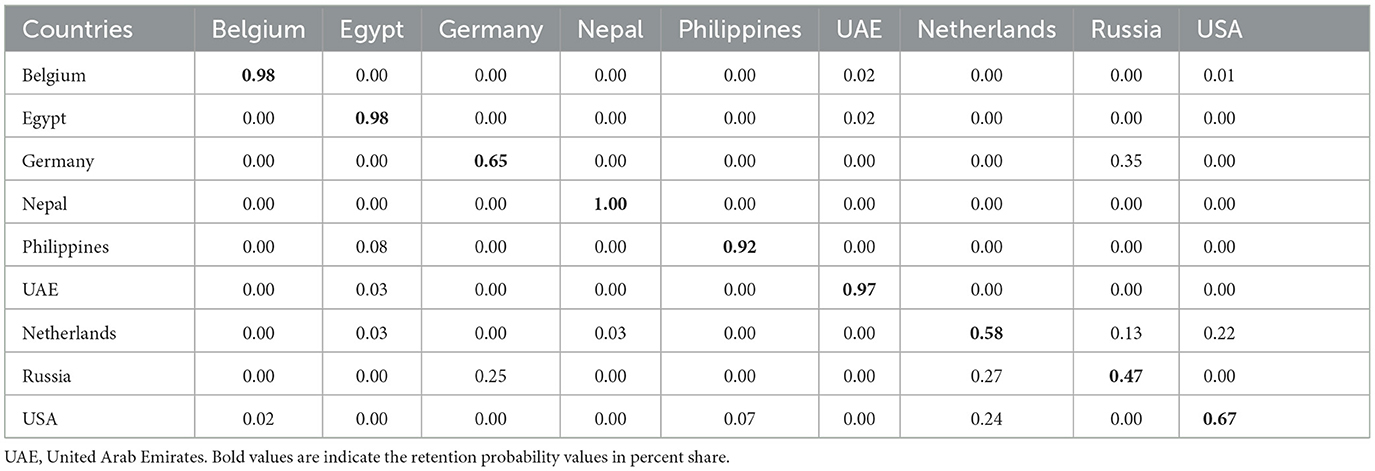
Table 10. Transitional probability matrix of tobacco exports during the post-FCTC regime, 2006–2018.
5.6 Projection of tobacco exports to major export destinations
The performance of the export of any commodity from a country is volatile and is determined by many tangible and intangible factors, such as strategic bilateral relationships, and the foreign trade policy of a country. However, we can predict the exports of a commodity based on some forecasting models such as the Markov chain model. The export of tobacco to different countries is forecasted using the transitional probability matrix for the next 3 years, that is, from 2023 to 2025 (Table 11).
The study forecasts that in 2023, the major markets for Indian tobacco will be Belgium, Egypt, and the United Arab Emirates, accounting for 23.07, 7.32, and 4.47%, respectively, of total exports. The projected exports to Belgium show a slight decline in both absolute values and share of total exports, which may be attributed to the possibility of losing market share to other countries. However, the predictive value of tobacco exports to Germany, the Netherlands, and Russia is expected to increase marginally from 2023 to 2025. Specifically, the projected market share of Germany, the Netherlands, and Russia will likely increase from 3.56 to 3.94%, 4.14 to 3.75%, and 4.09 to 4.72%, respectively. Notably, Russia is predicted to regain its position in the export market share. The projected export share to Egypt and Nepal remains the almost same from 2023 to 2025. However, in other export destinations (the Philippines and the United Arab Emirates), the projected values show a slightly declining trend, in both absolute and relative terms, which may be due to their loss of market share to other countries during the period analyzed.
6 Discussion
In tobacco exports, India has made tremendous progress in performance and global competitiveness in the past few decades and has emerged as the most reliable source of tobacco leaf supply to global markets. The export-oriented crop, FCV tobacco, possesses unique features, such as the regulatory mechanism of crop size fixation and its strict enforcement, a well-established e-auction system, export-building measures being in place, and the whole production system operating in apt mode. This has imparted stability in production, and prices in India (Tobacco Board, 2021–22). Nevertheless, currently, the tobacco industry is confronted with a whirlpool of opposite and contradictory concerns. This mainly relates to the income and livelihood security of multiple stakeholders involved in the tobacco supply chain, on one hand, and the public health risks due to consumption, on the other. In addition, another growing concern regarding deforestation due to the use of huge quantities of wood for FCV tobacco curing and the negative effects of smoking on health are widely documented, yet the significant negative effects of tobacco consumption and production on the environment are less recognized. The production, distribution, consumption, and growing and curing of tobacco all have an impact on the environment. Therefore, the FCTC tackles environmental issues in Articles 17 and 18 of the convention, which principally pertain to tobacco farming and trade. Furthermore, concerning the negative effects of tobacco consumption and manufacturing on the environment, Article 5.3 demands protection from the tobacco industry's influence on public policy across the globe (Geist et al., 2009; WHO FCTC World Health Organization Framework Convention on Tobacco Control, 2014).
6.1 Operating environment for FCV tobacco sector in India
Currently, the FCV tobacco sector in India is confronted with a whirlpool of differing and contradictory concerns. This is mainly associated with the income and livelihood security of multiple stakeholders involved in the supply chain on one hand and the public health and environmental issues associated with production and consumption on the other. Furthermore, factors such as national and international tobacco control policies, growing health consciousness, and public awareness about tobacco-related health concerns characterize upcoming challenges for FCV tobacco production. The FCV tobacco sector is confronted with both stabilizing and destabilizing factors in India.
6.1.1 Stabilizing and destabilizing factors
The factors imparting stability to the Indian FCV tobacco sector such as availability of zone-specific high-yielding varieties and improved agro-technologies for different FCV tobacco growing regions of the country. In the export markets, the price competitiveness, the growing global market demand for Karnataka tobacco (Mysore style), the marketing of FCV tobacco, a network of auction platforms, and a well-established e-auction system for transparent market transactions and ensuring remunerative prices. An organized policy regulated production system was established, where there is well well-developed institutional mechanism for area allotment, and production quota through annual crop-size fixation for FCV tobacco production regions of India. Moreover, the diverse climatic conditions in India also favor the production of different FCV styles that meet trade and industry requirements.
The main factors influencing tobacco production in the country such as international and national policies, such as WHO FCTC, 2005, to control the demand and supply of tobacco in India and the world, and COTPA, 2003, The Cigarettes and Other Tobacco Products (Prohibition of Advertisement and Regulation of Trade and Commerce, Production, Supply and Distribution) Act, 2003 (r COTPA) 2003 is an Act of Parliament of India enacted in 2003 to prohibit advertisement of, and to provide for the regulation of trade and commerce in, and production, supply and distribution of cigarettes and other tobacco products in India, and CDP (Crop Diversification Programs) from 2015–16 for the promotion of crop diversification programs to replace tobacco with other alternative crops in tobacco growing regions of the country. Furthermore, environmental concerns stem from the consumption (1.2 million metric tons of wood/annum) of huge quantities of fuel wood for curing and the resulting deforestation. Climatic aberrations, such as uneven and heavy rainfall, cyclones, floods, and droughts, severely affect FCV tobacco, especially in rain-fed conditions. The public's perception of tobacco is negative, which is changing consumer preferences and increasing health consciousness.
6.2 Impact of tobacco farming on public health and environment
Tobacco growing usually involves a substantial use of chemicals, including pesticides, fertilizers, and growth regulators (Prasad, 2007). These chemicals may affect drinking water sources because of run-off from tobacco-growing areas. Research has also shown that tobacco crops deplete soil nutrients by taking up more nitrogen, phosphorus, and potassium than other major crops. This depletion is compounded by topping and de-suckering plants, which increase the nicotine content and leaf yields of tobacco plants (Prasad, 2007). Land used for subsistence farming in low- and middle-income countries may be diverted to tobacco as a cash crop. Intensive lobbying and investments by multinational tobacco companies and leaf buyers along with market liberalization measures have encouraged the expansion of tobacco agriculture in low- and middle-income countries. Many of these countries have limited legislative and economic capacities to resist multinational tobacco companies' influence and investments. Because of expanded tobacco agriculture, there are short-term economic benefits for some farmers, but there will be long-term social, economic, health, and environmental detriments for many others (WHO—FCTC, 2015). The proliferation of tobacco agriculture in low- and middle-income countries has been encouraged by intensive lobbying, investments, and investments by multinational tobacco companies, as well as leaf buyers. Many nations do not have the legislative or financial resources to combat the investments and influence of Big Tobacco. Some farmers will benefit financially in the near term from the expansion of tobacco growing, while many others will suffer long-term social, economic, health, and environmental disadvantages (WHO—FCTC, 2015).
Several research studies have highlighted the negative effects of tobacco farming on various aspects, such as livelihood options, public health, and environmental degradation. For instance, a study conducted in Bangladesh showed that farmers chose to cultivate tobacco due to factors such as older age, low literacy levels, short-term financial support from tobacco companies, and the ease of selling of tobacco products in the market. The study suggested that institutional support should be extended to non-tobacco farmers to encourage alternative crops. In a comparative study of Slovakia's and Finland's compliance with the FCTC, Finland was found to have a clear anti-tobacco policy, with specific institutions responsible for implementing the convention. In contrast, Slovakia did not have designated institutions, resulting in a lower standard of compliance. This highlights the importance of effective implementation of the FCTC in achieving the goal of a smoking-free environment, as stated in the UN SDGs (Lecours et al., 2012). Tobacco farming also has significant environmental impacts, including soil fertility reduction, deforestation, and the release of nicotine into the environment. In India, the GATS found that both smokers and non-smokers are exposed to SHS in various public spaces, with women being more exposed in their homes and men in public places. Enforcing legislation to ensure a 100% smoke-free environment in all public places is crucial in addressing this issue (Global Adult Tobacco Survey Collaborative Group, 2020). In the recent past, the Ministry of Agriculture and Farmers Welfare, Government of India, introduced the crop diversification program implemented in 10 tobacco-growing states to support and incentivize tobacco farmers to shift to other economically viable alternative crops/cropping systems since 2015–2016.2 In summary, the adverse effects of tobacco farming on livelihoods, public health, and the environment demonstrate the need for policies and regulations that promote sustainable and healthy practices.
7 Conclusion and policy implications
Based on the analysis, tobacco exports are influenced by various factors, such as production, export price, and global demand. However, the implementation of the WHO FCTC has not had a significant impact on reducing tobacco production, consumption, and trade. Hence, there is a need for policy interventions that address the challenges associated with the tobacco sector, including health risks and environmental issues. The policy thrust should be on shaping the Indian tobacco sector in the context of changing policy regimes and achieving the SDGs, primarily SDG 3a. Other SDGs also address the negative effects of tobacco cultivation on development, and policy interventions need to look at alternatives for tobacco production.
Furthermore, it is essential to shift from tobacco cultivation to other economically viable farming enterprises on the path of accomplishing sustainable development, particularly in agriculture. Therefore, developing countries that are dependent on tobacco Production for livelihoods, income, and exports should pursue research on potential alternative enterprises. Finally, further studies are necessary to comprehend more insights into the tobacco economy in India, considering the gradual effect of the global implementation of the WHO FCTC on the overall size of the tobacco market. However, there are limitations of the research, such as aggravated social stigma/disgrace associated with tobacco and tobacco research, a shift in funding support from tobacco production to tobacco control, and data availability on some variables related to tobacco are to be mentioned.
Data availability statement
The original contributions presented in the study are included in the article/supplementary material, further inquiries can be directed to the corresponding author.
Author contributions
KVR: conceptualization and investigation. KVR, TI, and SA: methodology. KVR and TI: validation. KVR, TI, RS, and SA: formal analysis. KK: writing—original draft preparation. KVR, VP, SK, KK, KPR, and RS: writing—review and editing. PR and KVR: supervision. MM and KVR: project administration. All authors have read and agreed to the published version of the manuscript.
Acknowledgments
The authors express gratitude to the authors of various government reports which have been generously used in preparing this article, Indian Council of Agricultural Research–Central Tobacco Research Institute, Rajahmundry, Andhra Pradesh, India for providing necessary facilities and support.
Conflict of interest
The authors declare that the research was conducted in the absence of any commercial or financial relationships that could be construed as a potential conflict of interest.
Publisher's note
All claims expressed in this article are solely those of the authors and do not necessarily represent those of their affiliated organizations, or those of the publisher, the editors and the reviewers. Any product that may be evaluated in this article, or claim that may be made by its manufacturer, is not guaranteed or endorsed by the publisher.
Footnotes
1. ^Tobacco Board, Ministry of Industry and Commerce, Government of India, Annual Report. Available online at: https://tobaccoboard.com/tbdata/ Publications files.
2. ^Department of Agriculture and Farmers Welfare, Ministry of Agriculture and Farmers Welfare, and Government of India (2022).
References
Ali, I., Patthi, B., Singla, A., Dhama, K., Muchhal, M., Rajeev, A., and Khan, A. (2020). Assessment of implementation and compliance of (COTPA) Cigarette and Other Tobacco Products Act (2003) in open places of Delhi. J. Fam. Med. Prim. Care 9:3094. doi: 10.4103/jfmpc.jfmpc_24_20
APEDA (2020). Agricultural and Processed Food Products Export Development Authority (APEDA), Ministry of Commerce and Industry, Government of India. Available online at: https://apeda.gov.in/apedawebsite/ (accessed December 14, 2020).
APEDA (2021). Agricultural and Processed Food Products Export Development Authority (APEDA), Ministry of Commerce and Industry, Government of India. Available online at: https://apeda.gov.in/apedawebsite/ (accessed June 05, 2021).
Balassa, B. (1990). Incentive policies and export performance in Sub-Saharan Africa. World Dev. 18, 383–391. doi: 10.1016/0305-750X(90)90125-H
Dent, W. T. (1967). Application of Markov chain to International Wool Flows. Rev. Econ. Stat. 49, 613–616. doi: 10.2307/1928354
Espino, R., Mary, A., and Kin, F. (2013). Status of Tobacco Farming in the ASEAN Region. Bangkok: SEATCA (2013).
Eswaraprasad, Y., Achoth, L., and Radha, Y. (1997). Farm technology in relation to changing structure of landholding. Agric. Econ. Res. Rev. 10, 78–87.
FAOSTAT (2021). Food and Agriculture Data. Available online at: http://www.fao.org/faostat/en/#home (accessed January 25, 2023).
FAOSTAT (2023). Statistics Division Data of Food and Agriculture Organization. Available online at: http://www.fao.org/faostat/en (accessed January 25, 2023).
Fisher, W. D. (1967). Note on curve fitting with minimum deviations by linear programming. J. Am. Stat. Assoc. 56, 359–363. doi: 10.1080/01621459.1961.10482119
Gbetnkom, D., and Khan, S. A. (2002). Determinants of agricultural exports: the case of Cameroon. Afr. Econ. Res. Consort. 120, 1–41.
Geist, H. J., Chang, K.-T., Etges, V., and Abdallah, J. M. (2009). Tobacco growers at the crossroads: towards a comparison of diversification and ecosystem impacts. Land Use Policy 26, 1066–1079. doi: 10.1016/j.landusepol.2009.01.003
Global Adult Tobacco Survey Collaborative Group (2020). Global Adult Tobacco Survey (GATS): Fact Sheet Templates. Atlanta, GA: Centers for Disease Control and Prevention.
Gumilang, A. S., Jerey, D., Qing, L., Firman, W., and Raphael, L. (2020). In-and-out of tobacco farming: shifting behavior of tobacco farmers in Indonesia. Int. J. Environ. Res. Public Health 17, 9416. doi: 10.3390/ijerph17249416
Hema, M., Kumar, R., and Singh, N. P. (2007). Volatile price and declining profitability of black pepper in India: disquieting future. Agric. Econ. Res. Rev. 20, 61–76.
Janvry, A. D., and Sadoulet, E. (2010). Agricultural growth and poverty reduction: additional evidence. World Bank Res. Observ. (2010) 25, 1–20. doi: 10.1093/wbro/lkp015
Johansen, S., and Juselius, K. (1990). Maximum likelihood estimation and inference of co-integration with applications to the demand for money. Oxf. Bull. Econ. Stat. 52, 169–210. doi: 10.1111/j.1468-0084.1990.mp52002003.x
Krishna, V. R., Paramesh, V., Das, V. A. B., Elansary, H. O., Parab, A., Reddy, D. D., et al. (2020). Assessment of sustainability and priorities for development of Indian west coast region: an Application of Sustainable Livelihood Security Indicators. Sustainability 12, 8716. doi: 10.3390/su12208716
Kumar, N. R., Rai, A. B., and Rai, M. (2008). Export of cucumber and gherkin from india: performance, destinations, competitive and determinants. Agric. Econ. Res. Rev. 21, 130–138.
Lecours, N., Almeida, G. E. G., Abdallah, J. M., and Novotny, T. E. (2012). Environmental health impacts of tobacco farming: a review of the literature. Tob. Control 21, 191–196. doi: 10.1136/tobaccocontrol-2011-050318
Lee, T. H., and Keun, J. C. (1995). Further results on the long-run demand for money in Korea: a co-integration analysis. Int. Econ. J. 9, 103–113. doi: 10.1080/10168739500000024
Mandanna, P. K., Urs, D. S. D., and Achoth, L. (1998). Structural change in india's tobacco exports-A Markov Chain approach. Trop. Agric. Res. 10, 134–142.
Pavlikova, B., Freel, L., and van Dijk, J. P. (2020). Compliance with the framework convention on tobacco control in slovakia and finland: two different worlds. Int. J. Environ. Res. Public Health 17, 6661. doi: 10.3390/ijerph17186661
Prasad, V. M. (2007). “Case study of tobacco cultivation and alternate crops in India,” in The First Meeting of the Ad Hoc Study Group on Alternative Crops Established by the Conference of the Parties to the WHO Framework Convention on Tobacco Control. New Delhi: Ministry of Health & Family Welfare.
Reddy, K. V., and Reddy, D. D. (2022). Crop size fixation shields price volatility syndrome: analysis of some commercial crops in India. Ind. J. Econ. Dev. 18, 148–155. doi: 10.35716/IJED/21213
Reddy, K. V., Reddy, D. D., Rao, C. C. S., Hema, B., and Srinivas, A. (2017). Impact of FCV tobacco crop size reduction in Andhra Pradesh: adoption of alternative crops. Tob. Res. 43, 63–68.
Sekhar, C. S. C. (2003). Agricultural trade liberalization - Likely implication for rice sector in India. Ind. J. Agric. Econ. 58, 42–63.
Smith, J., and Fang, J. (2020). ‘If you kill tobacco, you kill Malawi': structural barriers to tobacco diversification for sustainable development. Sustain. Dev. 28, 1575–1583. doi: 10.1002/sd.2106
Talukder, A., Haq, I., Ali, M., and Drope, J. (2020). Factors associated with cultivation of tobacco in bangladesh: a multilevel modelling approach. Int. J. Environ. Res. Public Health 17, 4277. doi: 10.3390/ijerph17124277
Tobacco Board (2021–22). Annual Report. Available online at: https://tobaccoboard.com/tbdata/Publications/files/AR_2021-22_1.pdf (accessed January 30, 2023).
Tripathy, J. P. (2020). Secondhand smoke exposure at home and public places among smokers and non-smokers in India: findings from the Global Adult Tobacco Survey 2016-17. Environ. Sci. Pollut. Res. 27, 6033–6041. doi: 10.1007/s11356-019-07341-x
Tshibaka, T. (1997). Effects of Domestic Economic Policies and External Factors on Export Prices and Their Implications for Output and Income in Cameroon. AERC Final Report. Nairobi: AERC.
UNIDO (2012). Tanzania Industrial Competitiveness Report. Vienna: United Nations Industrial Development Organization (2012). Available online at: https://open.unido.org/api/documents/5096380/download/TANZANIA%20INDUSTRIAL%20COMPETITIVENESS%20REPORT%202012 (accessed December 8, 2023).
Wagner, H. H. (1959). Linear programming for regression analysis. J. Am. Stat. Assoc. 54, 206–212. doi: 10.1080/01621459.1959.10501506
WHO FCTC World Health Organization Framework Convention on Tobacco Control (2014). Outcomes of the Sixth Session of the Conference of the Parties, Report, Moscow, Russian Federation, 13–18 October. New Delhi: Ministry of Health & Family Welfare.
Keywords: tobacco exports, determinants, vector error-correction model, public health, environment, co-integration
Citation: Reddy KV, Paramesha V, Kumar KNR, Asci S, Immanuelraj TK, Madhav MS, Sendhil R, Konduru S, Rao KP and Ramasundaram P (2024) Econometric modeling of tobacco exports in the milieu of changing global and national policy regimes: repercussions on the Indian tobacco sector. Front. Environ. Econ. 2:1216153. doi: 10.3389/frevc.2023.1216153
Received: 23 June 2023; Accepted: 12 December 2023;
Published: 18 January 2024.
Edited by:
Gideon Danso-Abbeam, University for Development Studies, GhanaReviewed by:
Georgiana Raluca Ladaru, Bucharest Academy of Economic Studies, RomaniaRichard Adabah, CSIR Crops Research Institute, Ghana
Copyright © 2024 Reddy, Paramesha, Kumar, Asci, Immanuelraj, Madhav, Sendhil, Konduru, Rao and Ramasundaram. This is an open-access article distributed under the terms of the Creative Commons Attribution License (CC BY). The use, distribution or reproduction in other forums is permitted, provided the original author(s) and the copyright owner(s) are credited and that the original publication in this journal is cited, in accordance with accepted academic practice. No use, distribution or reproduction is permitted which does not comply with these terms.
*Correspondence: K. Viswanatha Reddy, vishu.uas@gmail.com
 K. Viswanatha Reddy
K. Viswanatha Reddy V. Paramesha2
V. Paramesha2 